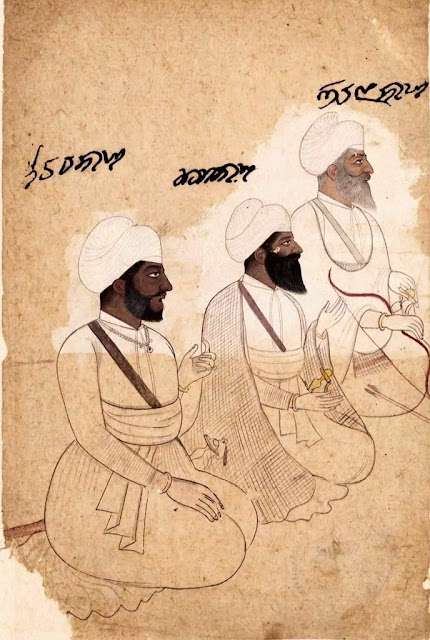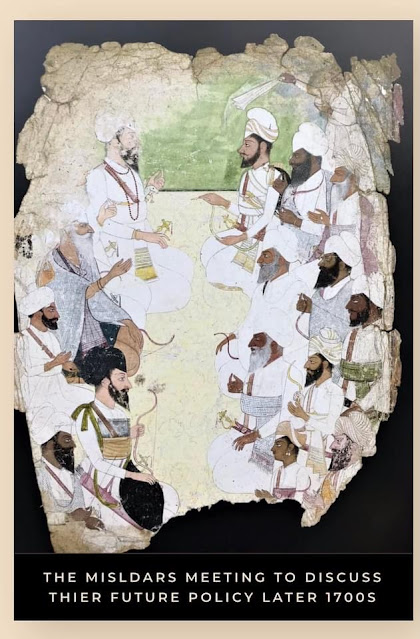Bhangi Misl marriage with Faizullapuria Misl
Through marriage, the Kahlons are connected with the house of Nawab Kapur Singh, a Virk Jat who is a major figure in Sikh history being 11 years old when Guru Gobind Singh died 1708 and 19 at the time of massacre of Baba Banda Singh Bahadur and his followers in Delhi in 1716.
He was the first leader of the Sikh nation after Banda Singh Bahadur, and in 1721 underwent initiation at the hands of Bhai Mani Singh, one of the most important Martyrs of the Sikh faith and a companion of Guru Gobind Singh himself...you will find his painting at every Sikh Gurdwara and read about him seperately.
Nawab Kapur Singh's brother was called Dhan Singh, and it is Dhan Singh's granddaughter that Sardar Lehna Singh Kahlon married who was the sister of Sardar Budh Singh Faizullapuria who inherited Kapur Singh's Misl..ie Nawab Kapur Singh's grand-niece.
Note : as the Bhangi Misl was the most powerful this was a good alliance for the two Misls, but Bhangi Misl Sardars contracted marriages with leaders of other Misls as well and you can read more below.
Nawab Kapur Singh founded the Faizullapuria Misl initially called the Singhpuria Misl after the village of Faizullapur near Amritsar which he had seized. After his death control of the Misl went to his nephew Budh Singh.
Budh Singh Faizullapuria, married his sister to Lehna Singh Bhangi of Lahore.
The reason that all the leading families made matrimonial alliances with each other was to stay powerful with the Bhangi Misl effectively the forerunner of the Lahore Darbar of Maharaja Ranjit Singh who adopted titles and coins of the Bhangi Misl as well as cities such as Lahore and many other territories from them.
Source : The Rise, Growth and Fall of the Bhangi Misl.
You can read more about these matrimonial alliances in the snippet from the same source below :
"Evidently, the Bhangis became the masters of substantial parts
of the Punjab, from river Indus to Jamuna and from Kashmir
mountains to Multan, on the extreme frontiers as well as in the
central Punjab. Amritsar had been open to all but the Bhangis were
the first to extend their control over the city of Amritsar. They had the
large army above 30,000 horsemen. Thus, they soon emerged as the
most powerful masters of the Punjab, during the seventh and eighth
decades of the eighteenth century. The autonomous position of the
Bhangi Sardars is apparent from the terms used for the individual
Sardars like Khalsa Ji, Singh Sahib or even Sarkar which were these
authority and independence as rulers is also indicated by the in the
Parwanas which they issued for the realization of their orders of
Dharmarth. Ganesh Das also uses the terms Khalsa Ji for Lehna Singh
and Gujjar Singh Bhangis and term Badshah for Hari Singh, Jhanda
Singh and Ganda Singh Bhangis. Ganesh Das uses the title Singh
Sahib for Gujjar Singh and Sahib Singh and he also refers to the
Bhangis as ‘the royal house of Banda Singh Bahadur’. These
manifestos of the sovereignty of the Khalsa marked the sovereign
status of the Bhangis.
To extend their territories and strength of the Misal they
cultivated friendly relations and matrimonial alliances with the other
Misaldars. This had the potential of creating a basis for rivalries
between Sardars. Some times, these Sardars of the Misals aligned
themselves on opposite sides just to underline rival Sardars as we see
in the dispute at Patiala, in 1765 when Bhangis with Ramgarhias and
their other associate Misals came to oppose the Phullkian chief Ala
Singh and at Jammu in 1774, when the Bhangis came opposite
Charat Singh Sukerchakia and Jai Singh Kanahiya in which Jhanda
Singh Bhangi was killed. From the political accounts of the various
Misals we find the Bhangis and Ramgarhias jointly fought against
Phullkians and Aluwalias; Sukerchakias and Kanahiyas against
Bhangis; Bhangis and Ramgarhia against Kanahiyas; Bhangis and
Kanahiyas against Sukerchakias; Bhangis, Ahluwalias and Kanahiyas
against Ramgarhias; Bhangis, Ramgarhias and Phullkians against
Karorsinghias; Ahluwalias, Sukerchakias against Bhangis. These
groups and regroups were made in view of the petty personal interests
of the Sardars, who changed sides as often as they changed their
shirts.
As has been observed they also entered into matrimonial
alliances with other Misals. Jassa Singh Ahluwalia married the
daughter of his cousin Bhag Singh to Gujjar Singh Bhangi’s eldest son
Sukha Singh; Sahib Singh son of Amar Singh married to Rattan Kaur
the daughter of Ganda Singh Bhangi; Subha Kaur daughter of Hamir Singh of Nabha married Sahib Singh son of Gujjar Singh Bhangi.
Khushal Singh Faizullapuria married his daughter to Man Singh
Bhangi son of Rai Singh Bhangi, who ruled over a part of Multan;
Budh Singh Faizullapuria, married his sister to Lehna Singh Bhangi of
Lahore; daughter of Nand Singh Bhangi of Pathankot married to Tara
Singh Kanahiya; Jai Singh married with the daughter of Bhag Singh Hallowalia; Mehtab Singh Kanahiya married his daughter to Tara
Singh Chainpuria; Fateh Singh Kanahiya married his daughter to Gulab Singh Bhangi; Sahib Singh Bhangi married Raj Kaur daughter of Charat Singh Sukerchakia. These marriages were thought to strengthen the positions of the concerned families and united them for the purpose of the combined action. In many cases their previous
rivalries and hostilities also come to an end with these matrimonial bonds.
The Bhangis retained the frontier positions in the Punjab, so the main burden of the Afghan invasions was on their shoulders. To liberate their land from the authority of the Afghans, they fought number of times with the Afghans under Ahmed Shah Abdali from
1748 to 1767 and after Ahmed Shah’s death in 1773, they continued
to be challenged by his son Timur Shah but in 1780 they lost the
famous city of Multan to Timur Shah. In 1793, Shah Zaman son of
Timur Shah opened his series of Indian invasions but was checked
again and again by the Sikhs, but at last he triumphantly entered the city of Lahore, in January, 1797. Here he tried to cultivate cordial
relations with Bhangis as his grandfather Ahmed Shah had earlier done and again offered the Governorship of Lahore to Sardar Lehna
Singh Bhangi one of the rulers of Lahore. Lehna Singh again declined"
Note that when Sardar Lehna Singh later built cenotaphs, monuments and gurdwaras in Lahore to the memory of men like Mani Singh or Taru Singh these were Martyrs connected to his HISTORY ie Nawab Kapur Singj had been iniitiated into the Khalsa by Mani Singh...and Lehna Singh had married Kapur Singhs grand-niece...to him it was living history of his own relations.


Comments
Post a Comment